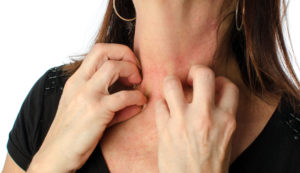What is Contact Dermatitis?
What is Contact Dermatitis?

Contact dermatitis is an inflammatory condition of the skin triggered by physical contact with certain chemical substances and/or plant products. Two different types of contact dermatitis are commonly observed.
- Irritant contact dermatitis: This is the more common condition caused by exposure of the skin to strong chemicals and/or solvents. The symptoms include stinging, burning, redness, peeling, and swelling. Soaps, detergents, acids, bases, saliva, urine, and stool are the most common triggers for irritant contact dermatitis.
- Allergic contact dermatitis: This condition is mediated by an immunological reaction in genetically susceptible and previously sensitized individuals. Cosmetics, topical medications, dyes, metals (e.g., nickel, gold), and certain food additives are common causes of allergic contact dermatitis. Latex in natural rubber products as well as oils from plants such as poison ivy, poison oak, and poison sumac are classic examples of allergic contact dermatitis. The symptoms usually begin several hours after contact and will generally last for several days.
Acute lesions can appear as red plaques covered with tiny fluid-filled blisters (i.e., vesicles). Chronic lesions usually take the appearance of eczema with thickening, scaling, and/or cracking of the skin. Reactions from cosmetics and fragrances usually involve the facial skin (especially the eyelids) and nickel sensitivity may cause dermatitis around the belly button, neck, and ear lobes. Sensitivity to rubber causes redness, blistering, and itching of the skin over hands after wearing latex gloves.
The diagnosis of allergic contact dermatitis involves performing patch testing. A variety of testing agents are placed over a small area of the skin, (usually over the back of the individual), and kept in place for 48 hours with the help of adhesives. The reactions to the patch testing agents are interpreted after 48 and 72 hours. Redness, swelling, and/or itching over the area of contact suggests sensitization to the substance. Avoiding the offending agent is the primary way to prevent the contact dermatitis.
Treatment:
- For acute lesions, cold compresses are helpful in relieving irritation and pain.
- When lesions are oozing, calamine lotion and oatmeal baths are beneficial.
- Topical anti-inflammatory agents (e.g., corticosteroid creams and ointments of varying potencies) are employed depending on the severity of the condition. Potential side effects can include thinning of the skin and discoloration determined by the strength and duration of treatment.
- Other agents that modulate the immune system [(e.g., Protopic (tacrolimus), Elidel (pimecrolimus)] may also be helpful although they are not specifically approved for this condition.
- Anti-bacterial medications can control infection and reduce the severity of dermatitis.
- Systemic corticosteroids (e.g., prednisone, methylprednisolone) are given when the condition is severe and does not respond to topical measures. They are employed only for a short duration to minimize the risk of side effects. Weight gain, bone thinning, peptic ulcers, cataracts, glaucoma, mood swings, and easy bruising are some of the known side effects of systemic steroids.
Identification of the offending substance and strict avoidance are keys to prevention of further episodes of both irritant and allergic contact dermatitis. Using mild soaps and detergents, and cosmetics free of strong fragrances can minimize irritant reactions. Based on the patch testing results, one may need to avoid certain hair dyes and nail polishes.
The board certified allergists at Black & Kletz Allergy have been practicing allergy and immunology for more than 50 years and are happy to help you with your skin condition whether it be due to contact dermatitis, eczema, or hives. We have 3 convenient office locations in the Washington, DC, Northern Virginia, and Maryland metropolitan area. Please call us today to schedule an appointment or consultation.












